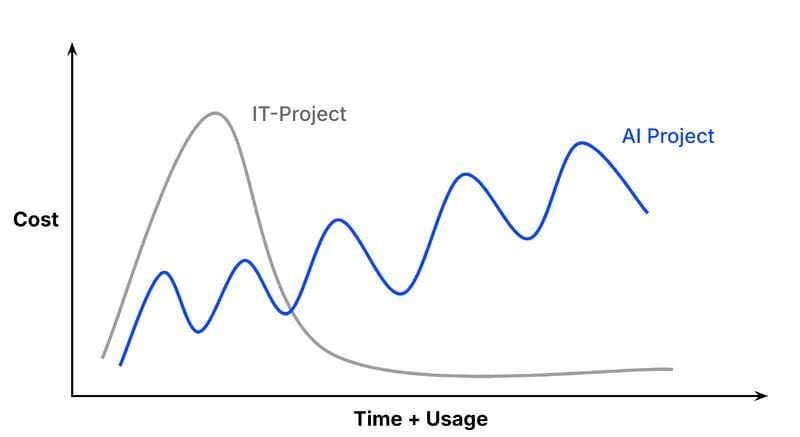8 bits for a Byte:
Want to derail your AI transformation fast? Force your top talent into a rigid return-to-office policy. In this issue, we unpack why the RTO debate isn’t just a workplace squabble—it’s a make-or-break moment for innovation, trust, and AI acceleration. Where and how your team works is now strategic, not just operational. Plus, we’re experimenting with a fresh newsletter format—let us know what resonates by dropping your thoughts at the bottom of the newsletter.
Get the tools, gain a teammate
Impress clients with online proposals, contracts, and payments.
Simplify your workload, workflow, and workweek with AI.
Get the behind-the-scenes business partner you deserve.

AI Quick Bytes is proud to offer it’s subscriber free tickets to AI DevSummit 2025
AI DevSummit 2025 (May 28-29, South San Francisco, CA) + (June 4-5, Live Online) is the premier conference for engineers and data teams shipping real-world AI. AI DevWorld brings together AI/ML engineers, data scientists, and technical leads for two days of hands-on sessions, case studies, and conversations focused on production-scale systems. Learn from leaders at Google, Amazon, Meta, Intuit, Lyft, Akamai, Deloitte, Toyota, Strava, and many more!
Choose from sessions across 6 Conference Tracks:
Frameworks, Tools, and Applied AI
Data Access, Management, and Operations
Machine Learning, Models, and Architectures
Productizing AI
AI Leadership & Strategy
AI Security, Ethics, Governance & Compliance
The AI DevSummit team has offered our group 25 free OPEN Passes so our members can attend for free.

Let’s Get To It!

Back to the Office—At What Cost to AI Innovation?
The insistent rhythm of calls for a full-scale return to the physical office is growing louder. Uber CEO Dara Khosrowshahi’s recent stark directive—essentially, "come back or find opportunities elsewhere"—is merely the latest, most public example. Though the policy details often reveal a more moderate 3-day-a-week mandate, the ultimatum-like tone reflects a wider trend among top executives. Amazon, JPMorgan Chase, AT&T, Dell, and numerous other major corporations are similarly urging, if not mandating, more days in the office, signaling a move back towards pre-pandemic norms. The official reasons often highlight collaboration, culture, and productivity. But we must ask: are these mandates truly paving the way for a stronger future, or are they a significant gamble that could backfire, especially as companies race towards an AI-driven world?
This isn't just a scattered trend. Recent surveys show a clear shift, with a KPMG report indicating that 83% of CEOs expect a full return to office environments within the next three years. Yet, this executive push directly collides with prevailing employee sentiment. Data consistently shows a strong preference for hybrid or remote work, with only about one in five employees (around 21%) wanting a full-time office presence. More critically, companies known for being remote-friendly continue to attract a large share of top engineering talent—the very minds crucial for the next wave of innovation.
Deconstructing the "Why": Control, Culture, or Genuine Collaboration?
On the surface, CEOs promote Return to Office for its supposed benefits to teamwork, mentorship, and that somewhat vague concept of "company culture." The argument is that chance encounters and in-person brainstorming are vital. But beneath these stated reasons, other factors may be at play. Is the real push about "creating a better culture, or just controlling one?" When mandates are issued with a "like it or leave it" feel, it’s reasonable to question if this is less about fostering organic connections and more about reasserting managerial authority—a shift in a power dynamic that had tilted towards employees. Some observers note that executive preferences, sometimes shaped by long-standing habits, can play a significant role in these decisions, occasionally taking precedence over purely data-driven approaches.
The common belief that physical presence automatically equals higher productivity also needs a closer look. Studies, including one from the University of Pittsburgh, have found that RTO mandates often lead to noticeable drops in employee job satisfaction without a clear, corresponding improvement in company performance. There's also ongoing discussion that some RTO initiatives might be subtly aimed at cost-cutting through "voluntary" departures or are driven by commitments to commercial real estate.
However, it's important to acknowledge that there can be a "special chemistry" that emerges from in-person interaction—a dynamic quality that current virtual tools, despite their advancements, struggle to replicate entirely. These are the deep bonds of culture and trust that can indeed form the foundation for truly transformative, collaborative work. But the crucial distinction lies in how this chemistry is nurtured. Is it through rigid, top-down rules, or by creating an environment so compelling and purposeful that people genuinely want to be there?
The AI Imperative: Where Human Chemistry Meets Machine Intelligence
This entire debate is happening as we stand on the edge of an AI revolution. For companies, successfully navigating this transformation isn't just about keeping up with trends (FOMO); it's about a fundamental "fear of surviving." Integrating AI effectively is not a simple plug-and-play operation. As I’ve noted before, "Implementing AI takes enormous operational and human effort, requiring more than a vision and strategy but a rewriting of how companies work." No department will remain untouched by this shift.
We are, arguably, in the "MS-DOS days of AI." The current stage of AI development and implementation is complex, often not yet seamless, and requires intensive, hands-on collaboration. This isn't like deploying mature software; it’s foundational work that demands a different level of human ingenuity and teamwork. The "speed of innovation will condense the PC cycle of societal impact," meaning the timeframe to adapt and lead is becoming incredibly short.
This is where that "special chemistry" becomes particularly important. Max Faingezicht, reflecting on this, aptly stated, "AI transformation must be built on a foundation of respect and trust." The "cross-vertical collaborations" essential for successful AI implementation—breaking down traditional department silos and fostering combined innovation—are significantly boosted by these deep bonds. When trust is high, and communication channels are rich and nuanced (as they often can be with in-person interaction), the difficult, pioneering work of embedding AI across an organization becomes much more achievable.
The Talent Equation: An Unintended Brain Drain?
Herein lies a key paradox: the very mandates intended to strengthen companies for the AI era might actually be undermining that goal. As one insightful commentator remarked, "flexibility is no longer a perk, it's a competitive edge." Top talent, especially the "A+ builders" crucial for AI development, generally don't respond well to ultimatums. They can, and will, go where they are valued. Many are already choosing remote-first or highly flexible teams where their "output is valued more than their office optics."
Are companies "willing to lose A+ talent over a badge swipe?" Rigid RTO mandates risk eroding the trust and autonomy that are, ironically, essential for the kind of innovative, risk-taking culture that AI transformation demands. If the message from leadership is perceived as being more about control than empowerment, the best minds may seek environments where they are trusted to deliver, regardless of their physical location.
Forging a Path Forward: Beyond a Simple Yes/No Mandate
The decision about where work gets done is "not a yes/no decision." A more nuanced approach is essential. If some in-office presence is indeed valuable for fostering that "special chemistry" crucial for AI's early, intensive phases, how can it be achieved without alienating talent or reverting to outdated command-and-control models?
The true test for leadership is to shift from simply dictating presence to cultivating purpose. How can leaders foster genuine connection and purpose-driven collaboration, making office time valuable and sought-after, rather than a resented obligation?
This involves creating environments where people feel respected, where their contributions are valued over their location, and where in-person gatherings are designed for specific, high-value interactions that truly benefit from being co-located. Leadership that builds the necessary trust for AI transformation understands that it’s about enabling their people, not just monitoring them.
The long-term impacts for companies that misjudge this moment could be severe. Those who cling to rigid, unpopular mandates may find themselves facing a talent drain, diminished innovation, and a loss of agility—all critical weaknesses in the rapidly evolving AI landscape. As we watch this situation unfold, the question remains: Are these sweeping RTO mandates a necessary, strategic move to rebuild culture and speed for the AI revolution, or are they, perhaps, a "leadership failure dressed up as 'alignment'"? The answer will significantly shape the winners and losers in the coming era. The future isn't just about where we work, but how we empower our brightest minds to build it, together.

Want unlimited AI, ASAP?
Get up to 6 months of Plus plan + unlimited AI free!
Launch and scale your startup faster with Notion.
Visit the Notion for Startups page to get the offer.

Quote of the week

It's a striking paradox in the corporate world: even positive change can evoke significant fear, leading to a reluctance to shift habits or experiment. This human element is crucial when considering the insight that 'Artificial intelligence is not a strategy, but a means to rethink your strategy... empowering people with intelligent tools to adapt.' If AI is to fulfill its role as an enabler of adaptation in our 'era of exponential change,' we must directly confront this inherent fear. The most effective way to do so is by equipping our workforce with the right AI tools, coupled with robust training and a supportive ecosystem, thereby building the confidence and competence they need to not just accept, but champion, the transformative potential of AI. I have always been surprised by the fear people have of change, even when it is a known good for us, there is still a fear in doing something different and reluctance to experiment. Providing the right tools, training and support to your workforce will help to build the foundation that they need to succeed.


Sunday Funny: Be honest is your Data Ready for AI?

Fact-based news without bias awaits. Make 1440 your choice today.
Overwhelmed by biased news? Cut through the clutter and get straight facts with your daily 1440 digest. From politics to sports, join millions who start their day informed.

Until next time, take it one bit at a time!
Rob
Thank you for scrolling all the way to the end! As a bonus check out:
AI initiatives frequently demonstrate 'inverse economics,' where operational costs for continuous model maintenance, data pipelines, and usage-based scaling tend to escalate post-deployment, unlike traditional IT projects. This necessitates viewing AI not as a one-time capital expenditure but as an evolving 'digital worker' requiring sustained investment; consequently, an AI project delivering savings that are eclipsed by its running costs is a net business loss, underscoring the critical need for upfront financial models that ensure projected value significantly and sustainably outpaces these inherent, recurring expenditures.
P.S.
Join thousands of satisfied readers and get our expertly curated selection of top newsletters delivered to you. Subscribe now for free and never miss out on the best content across the web!






